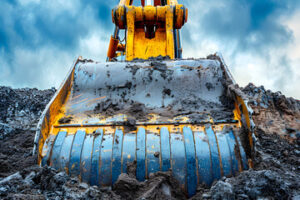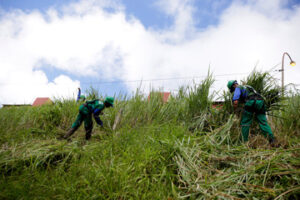An Excavating Contractor lays the groundwork for construction projects by using advanced machinery. Their work demands strength, strategic planning, and precision to build foundations that support enduring structures.
This professional’s duties include obtaining local permits for excavation and identifying and marking underground utilities to prevent accidental damage. They also ensure that the site is accessible for construction vehicles and equipment. Visit bartexcavationllc.com to learn more.

Often the first step in construction projects, excavation contractors are responsible for clearing, digging, and grading land. This is a critical process that directly impacts the stability, safety, and efficiency of subsequent building endeavors.
Clearing Sites
Whether they’re preparing for home additions, swimming pools, or commercial development, excavating contractors must carefully clear away existing materials and vegetation before the construction process begins. This includes removing trees, clearing land, and disposing of all waste material in an environmentally friendly manner.
Rough Staking
Before the actual excavation can begin, an experienced contractor will perform a rough staking job. This involves identifying the boundaries and ideal plan of action for a project. It also showcases any potential hazards or obstacles that may hinder the progress of a dig and recommends steps to eliminate them.
Installing Specialty Soils
As a part of the preparation process, an excavation contractor can also use their skills to enhance soil conditions. This could include adding engineered fill or other specialty soil blends to improve a property’s load-bearing capacity, drainage, and stability before construction begins.
One of the most important parts of an excavation is locating and protecting utility lines. Accidentally hitting water, gas, or electrical pipes can cause major disruptions and additional costs. Contractors will carefully excavate around these utilities using techniques like utility locating and careful digging to avoid any damage.
As the excavation work continues, an experienced contractor will use a variety of heavy equipment to grade and prepare the ground for construction activities. They will carefully adjust the slope and contours of the land to match the required elevations outlined in the construction plans. This ensures that the foundation of any new structures will be strong, sturdy, and structurally sound. Erosion control measures are also a key part of this process, as they prevent pollutants from reaching local waterways and causing environmental damage.
Excavation
Before digging begins, excavation contractors inspect the site and consult with clients to develop an effective strategy. They provide expert insights based on soil analysis and topographical surveys. They also discuss challenges like the presence of underground utilities and how to approach them. This information is critical for ensuring the foundation of a construction project is solid and avoiding costly mistakes down the line.
Depending on the scope of a project, excavating contractors may dig openings in the ground for building foundations or trenches for utility operations. They use specialized machinery and advanced strategies to improve efficiency and quality. They also ensure the safety of workers and the general public by following strict protocols and employing trained professionals.
In addition to preparing and conducting excavation work, an excavating contractor may provide related services like land alteration, grading, and drainage correction. They often have established relationships with suppliers and can get materials at a lower cost than if they were to purchase them themselves. They also understand the importance of meeting deadlines and staying within budget, which can help businesses manage their projects effectively.
Professional excavation companies are able to save customers money in the long run by completing projects efficiently and correctly. They can prevent damage to existing utilities, which would otherwise require expensive repair costs, and complete the work without affecting other properties. They also have the proper insurance coverage that protects against property exposures resulting from equipment and vehicle accidents.
Considering the complexity and size of most excavation projects, it is important to partner with an experienced contractor. Look for a business with a solid track record, licensed workers, and a strong reputation for providing high-quality service. Inspect their website for positive customer feedback and check their license to ensure they meet local safety and professionalism standards. Also, be sure to ask about any job site cleanup services they offer. Many excavating companies provide this service, but some do not, so it is important to be clear about your expectations ahead of time. Also, make sure that the company you select provides insurance that covers any damage caused to your property by their equipment or vehicles during transportation and storage.
Integrating Vital Infrastructure
Besides digging holes and trenches, excavation contractors also lay the groundwork for vital infrastructure like water lines, sewer lines, electricity, gas, and telecommunication cables. They make sure that these pipes and lines are properly laid out to accommodate construction activities while also ensuring that they will be easy to access for future maintenance or repairs.
Soil consistency is another important factor that excavating contractors must address before construction can begin. They may conduct a series of tests to determine whether the soil is solid enough to support the weight and structure of building structures. They may also add stabilizing materials to the dirt to improve its quality.
Another service that excavating contractors provide is land clearing. This involves removing trees, brush, and debris from the site to prepare it for new construction. They often use heavy equipment to carry out these tasks. Because of the size and power of the machinery, it is important to hire a contractor with experience in this type of work to minimize disruptions and accidents.
One of the biggest challenges that excavation contractors face is the risk of hitting underground utility lines. These could be water, gas, or electrical lines that are buried a few feet beneath the surface. Accidentally hitting these lines can cause severe disruptions and lead to expensive repair costs. Contractors can reduce this risk by contacting local utility providers before beginning their excavation work. They can then request that these lines be marked before starting to work.
Drainage is also a major concern for excavation contractors. Poor drainage can lead to foundation problems, basement flooding, and landscape erosion. By grading the land and installing drainage pipes, these professionals can redirect water runoff away from the construction site and prevent these issues.
In some cases, excavation may uncover items of historical significance that require special care and handling. These discoveries may include artifacts from indigenous civilizations, war relics, or even dinosaur bones. Depending on their location, these finds can delay the project or require an archeological team to come in and assess them. It is up to the excavation contractor to deal with these items in a responsible manner so that they can be recovered and preserved for future generations.
Project Management
While excavation may seem like a small part of the construction process, it’s an important first step. Excavating contractors are responsible for much more than simply moving dirt – they’re involved in preparing the land for all future construction endeavors, managing underground utilities safely, strategically planning the site to support the weight and structure of future structures, and more. By doing this, they not only lay the foundation for construction success, but also head off potential issues that could derail construction later on.
To prepare the construction site, excavating contractors clear away existing structures and vegetation and remove any debris or hazardous materials from the excavation site. This is a significant part of the job because it’s necessary for the safety of workers and the integrity of the excavation work. Additionally, the clearing process can expose any hidden hazards or obstructions that could impact the project’s timeline or budget.
Another critical part of excavation is soil stabilization and preparation, which involves incorporating the right amount of organic material to create an even, stable base for construction and prevent erosion. In addition, grading the terrain is crucial to making sure water drains away from construction sites rather than pooling or washing sediment into nearby natural or municipal waterways.
Excavating contractors are also tasked with protecting the environment during and after excavation by ensuring that all construction activities adhere to environmental standards. This often means relocating fauna, creating barriers to protect habitats, and scheduling work during times that don’t disturb breeding seasons.
Finally, excavation contractors must ensure that the soil is adequately graded to meet the specifications outlined in the construction plans. This can involve reshaping the ground’s elevation by using heavy machinery to adjust the terrain’s slope and contour. It’s essential for establishing proper drainage, maintaining site stability and ensuring that the final structure will be constructed at the desired elevation.
As you can see, excavation contractors are responsible for a huge variety of tasks that help make construction projects possible. This is why it’s so important to hire qualified, reliable excavation contractors for any project. Choosing the wrong contractor can not only delay construction, but it can also lead to costly errors and setbacks down the road.

